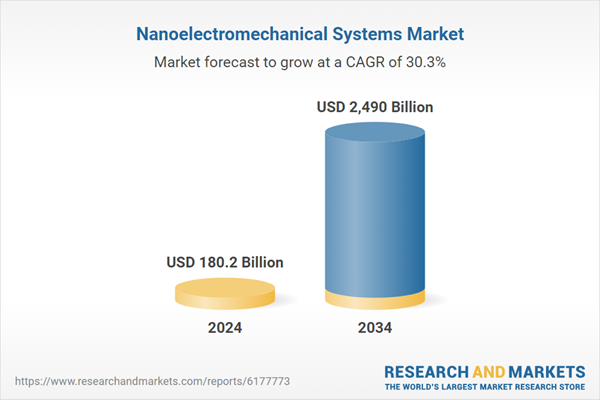The robust growth is owing to the demand for ultra-miniaturized devices with superior functionality. As electronic components become increasingly compact, NEMS are gaining traction for their unmatched capabilities in nanoscale actuation, sensing, and signal processing. Industries such as consumer electronics, biomedical devices, next-gen wearables, and smart implants are pushing toward reduced form factors, prompting manufacturers to integrate NEMS into their innovations. Their application scope continues to expand as miniaturization remains a driving factor in modern device design and engineering.
Significant strides in materials science, particularly with graphene, carbon nanotubes, and advanced silicon nanostructures, are further enhancing the performance of NEMS technologies. These materials deliver superior mechanical properties, efficient energy utilization, and high electrical performance at the nano scale. With continuous innovation in fabrication techniques and functional design, NEMS are evolving into commercially viable solutions across sectors like medical diagnostics, environmental monitoring, and computing systems. As development scales, demand is surging for systems capable of real-time monitoring, micro-level precision, and autonomous operation.
In 2024, the nano-switches segment generated USD 62.8 billion. Their widespread adoption stems from their ability to function reliably in ultra-small devices while delivering high-speed switching and low-power consumption. Meanwhile, demand for nano-tweezers continues to grow due to their precision handling of nanoscale materials in research fields like molecular biology and nanomedicine. These devices are now critical for manipulating individual molecules and cells, enabling breakthroughs in single-cell diagnostics and targeted therapy delivery.
The graphene segment generated USD 49.8 billion in 2024. Known for its exceptional strength, conductivity, and flexibility, graphene is rapidly becoming essential for manufacturing high-frequency transistors, nanoscale sensors, and efficient nano-switches. It meets the increasing demand for faster, low-power electronics in computing and communication. Additionally, graphene’s biocompatibility is propelling its use in biosensing and medical NEMS applications where precision and safety are vital.
U.S. Nanoelectromechanical Systems Market generated USD 56.7 billion in 2024 with a CAGR of 29.4%. This growth is driven by ongoing government support for nanotech research, deep collaboration among tech firms and academic institutions, and the expanding footprint of NEMS across industries like defense, healthcare, aerospace, and consumer electronics. A favorable investment environment and strong IP protections also reinforce U.S. leadership in this space.
Key players shaping the competitive landscape of the Nanoelectromechanical Systems Market include Ubiquiti Inc., Interuniversity Microelectronics Centre, Inframat Advanced Materials LLC, Bruker Corporation, Broadcom Corporation, Showa Denko K.K., Merck KGaA, Sun Innovations, Inc., Fraunhofer-Gesellschaft, Raymor Industries Inc., Nanoshell Company, LLC, onex technologies Inc., Cnano Technology Limited, JBC S.L., and Electron Microscopy Sciences.
To build a stronger foothold in the evolving Nanoelectromechanical Systems Market, companies are prioritizing R&D investments in material innovation, focusing particularly on nanomaterials like graphene and carbon-based composites. They are also expanding partnerships with academic research labs and public institutions to accelerate technology development and commercialization. Strategies include diversifying application portfolios into sectors like aerospace, bioscience, and smart infrastructure, while also improving manufacturing scalability. Some players are focusing on precision nanofabrication methods to enhance device sensitivity and durability, while others aim to reduce energy consumption for high-efficiency solutions.
Comprehensive Market Analysis and Forecast
- Industry trends, key growth drivers, challenges, future opportunities, and regulatory landscape
- Competitive landscape with Porter’s Five Forces and PESTEL analysis
- Market size, segmentation, and regional forecasts
- In-depth company profiles, business strategies, financial insights, and SWOT analysis
This product will be delivered within 2-4 business days.
Table of Contents
Companies Mentioned
The companies profiled in this Nanoelectromechanical Systems market report include:- Aeotec Limited
- Agilent Technologies
- Amprius Technologies
- Analog Devices, Inc.
- Applied Nanotools Inc.
- Asylum Research Corporation
- Broadcom Corporation
- Bruker Corporation
- Cnano Technology Limited
- Electron Microscopy Sciences
- Fraunhofer-Gesellschaft
- Inframat Advanced Materials LLC
- Interuniversity Microelectronics Centre
- JBC S.L
- Merck KGaA
- Nanoshell Company, LLC
- Onex technologies inc
- Raymor Industries Inc.
- Showa Denko K.K.
- Sun Innovations, Inc.
- Ubiquiti Inc.
- Vistec Electron Beam GmbH
Table Information
| Report Attribute | Details |
|---|---|
| No. of Pages | 180 |
| Published | September 2025 |
| Forecast Period | 2024 - 2034 |
| Estimated Market Value ( USD | $ 180.2 Billion |
| Forecasted Market Value ( USD | $ 2490 Billion |
| Compound Annual Growth Rate | 30.3% |
| Regions Covered | Global |
| No. of Companies Mentioned | 23 |









